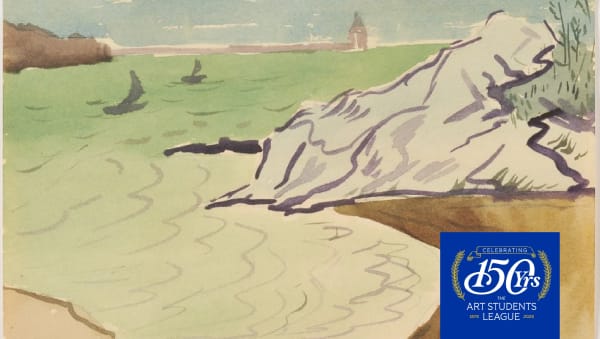Nicolas Carone
"If you look at the sidewalks on a rainy day after the rain, study all the marks, you see great paintings. But only an artist can see it. Another guy sees spots. But as a painter, I look at them all the time."
– Nicolas Carone (Interview with Frank Messina, 2006)
Nicolas Carone was born to an Italian-American family in New York’s Lower East Side on June 4, 1917. His father worked as a bartender and stevedore, who owned horses and delivered coal and ice. His mother liked to entertain friends and family and encouraged her children to pursue art and music. Carone was the oldest of seven children: three brothers and two sisters. His brother, Matthew Carone, is also an artist, who lives in Florida and opened a gallery in Fort Lauderdale in 1959.
The family moved to Hoboken, New Jersey when Carone was about five years old, and already interested in art. He began taking classes at the Leonardo da Vinci School at St. Mark’s Church in Manhattan when he was eleven, traveling on his own from New Jersey to New York.
Carone dropped out of high school when he was fourteen to study art full-time. He attended the National academy of Design, the Art Students League and the Hans Hoffman School of Fine Arts.
In 1941 he was awarded the Prix de Rome but couldn’t go to Italy because war broke out and he spent net three years in the army. He was based in the U.S. and was able to continue his studies with Hoffman during his furloughs.
Carone received a Fulbright Fellowship in 1949 and he was able to travel to Italy. He stayed there for three years, painting and meeting many of Italy’s finest artists. He had his first solo exhibit at the Cortilla Gallery in Rome.
He returned to the U.S. and established a studio in New York, where he met with many of America’s first generation of Abstract Expressionists. In 1951, Carone’s work was included in the Ninth Street Art Exhibit, curated by Leo Castelli. The show included about 75 wonderful artists like Helen Frankenthaler, Joan Mitchell, Grace Hartigan, Robert De Niro Sr., Jackson Pollock, Robert Rauschenberg, Willem de Kooning, Elaine de Kooning, Lee Krasner, Franz Kline, Ad Reinhardt, Robert Motherwell, Barnett Newman, and many others who were then mostly unknown to an art establishment that ignored experimental art without a ready market. Not a single work was sold during the 20-day exhibit, but the artists and their artworks had the exposure they needed to become a force in the art world.
Carone helped to establish the Stable Gallery on Central Park South in 1953. Many of the same artists who participated in the Ninth Street show, had their work exhibited at the gallery, which had been an actual stable. The Stable Annual, like the Ninth Street Art Exhibit, was a great success for the artists who participated.
In 1957, Carone’s work was shown at the Venice Biennale. The following year his work was included at Expo 58, the Brussels World Fair, in the American Pavilion.
He was invited to teach and mentor at Columbia University, Cooper Union, Brandeis and Cornell. In 1964 he became part of the founding faculty at the New York Studio School, where he taught drawing for more than twenty years. He was given a Lifetime Achievement Award from the Pollock-Krasner Foundation.
In 1988 he established an art school in the Umbrian region of Italy, which ran for ten years. He had a home in Doglio, Italy and in New York.
After a long hiatus, Carone began to exhibit his work again in New York in 2005, and continued to have shows until his death.
Carone Died at his home in Hudson, New York, on July 15, 2010 at age 93.
He was married twice. He had one son from his first marriage and twin sons from his second.
Nicolas Carone's work is in the permanent collection of the Whitney Museum of American Art, the Metropolitan Museum of Art, the Hirshhorn Museum and Sculpture Garden, the Baltimore Museum of Art and the Mobile Museum of Art.
References:
Frank Messina. Nicolas Carone: Jazz, Poetry and Jackson Pollock. Fine Art Investigations/International Edition.
Phong Bùi. The Stable Gallery: In Conversation With Nicolas Carone. The Brooklyn Rail. Early Summer 2002.
Paul Cummings for the Archives of American Art. Oral History Interview with Nicholas Carone, 1968. May 11 - 17.
Roberta Smith. Nicolas Carone, Abstract Expressionist, Dies at 93.
Send me more information on Nicolas Carone
-

The Art Students League Celebrates 150 Years
Showcased works by Milton Avery, Adolph Gottlieb and other Art Students League Alumni June 20, 2025The Art Students League of New York is celebrating its 150th anniversary with an exhibition of works by many of its most talented artists. The...Read more -

Great Artists, Great Teachers: Hans Hofmann, Thomas Hart Benton and Nicolas Carone
August 23, 2024A teacher affects eternity; he can never tell where his influence stops. – Hans Hofmann As an artist and a teacher, Hans Hofmann (1880-1966) had...Read more -

Milton Avery and the Federation of Modern Painters and Sculptors
August 14, 2024“ I like to seize the one sharp instant in Nature, to imprison it by means of ordered shapes and space relationships. To this end...Read more





